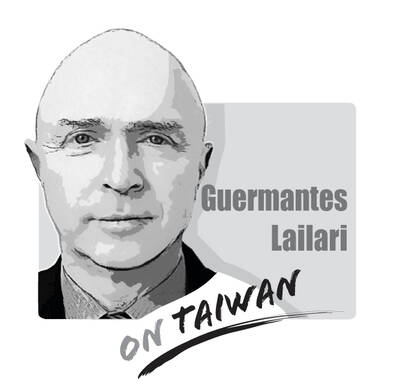US President Donald Trump has said that he plans to impose substantial tariffs on semiconductors and pharmaceuticals to force companies to move production from Taiwan and around the world to the US. He also said the US economy could be boosted by US$20 trillion by the end of this year, in large part due to companies moving their operations to the US to avoid tariffs.
While Trump’s tariffs face legal challenges, the US president has maintained that his “America First” trade stance would spur more domestic manufacturing and reshoring of important industries to the US. Yet, Trump’s protectionist policies have stirred significant turmoil in global supply chains and, for Taiwan in particular, it has raised concerns about whether semiconductor investment in the US and local manufacturers’ expansions overseas would reduce their operations at home, leading to an outflow of talent and the hollowing out of local industries.
National Development Council Minister Yeh Chun-hsien (葉俊顯) last week downplayed such concerns. Taiwan’s tech investment in the US is not about carving off part of its industry, but simply duplicating its development in a new location, he told a meeting of the legislature’s Economics Committee. A critical mistake of the US’ trade policies of the 1980s was in shifting a portion of its manufacturing to Southeast Asia, Yeh said. Taiwan seeks to retain manufacturing, especially critical and advanced manufacturing, while helping the US cultivate its talent pool, he added.
Manufacturers around the world are contending with the complex decision of shifting supply chains to avoid high US tariffs, and Taiwanese companies are no exception. With a declining birthrate, the nation is no longer able to shore up a large labor base in manufacturing, and the US’ tariffs give firms a motive to relocate abroad. That movement would create a short-term crisis of reduced exports, job losses and less manufacturing in some parts of Taiwan. Small and medium-sized enterprises in southern and central Taiwan would be particularly affected.
However, Pegatron Corp chairman Tung Tzu-hsien (童子賢) remains confident in Taiwan’s industrial competitiveness. At a semiconductor conference last week, Tung said that previous overseas expansions of Taiwanese firms did not hollow out local industries, but helped enhance companies’ capabilities and grow Taiwan’s influence on a global stage, because the core of research and development and the decisionmaking remain in Taiwan.
In the 1980s, Taiwan’s traditional industries, such as plastics and textiles, led the first wave of relocation to China due to the appreciation of the New Taiwan dollar, followed by upstream and midstream raw material suppliers. In about 2000, the same pattern of relocation emerged in the information and communications technology industry. However, the waves of relocation have not created a hollowing-out effect on Taiwan’s domestic industrial base, but instead have ushered in a wave of booming new industries. Intermediate goods, such as key electronic components and semiconductors, have also become the new main export items and new markets for Taiwan-made goods have been created.
A speedier relocation of Taiwanese firms could occur this time, as higher and broader US tariffs might prompt more manufacturers to expand their presence in alternative, lower-tariffed markets. As long as Taiwan retains critical technology and advanced manufacturing at home, harbors an environment conducive to the development of newer and more dynamic companies here, and further develops the EU and emerging markets to reduce dependence on a single market, while firms’ technological innovations, such as artificial intelligence and robotics, in Taiwan can outgrow their pace of relocation, the crisis could be converted into an opportunity for Taiwan’s industries.

Chinese state-owned companies COSCO Shipping Corporation and China Merchants have a 30 percent stake in Kaohsiung Port’s Kao Ming Container Terminal (Terminal No. 6) and COSCO leases Berths 65 and 66. It is extremely dangerous to allow Chinese companies or state-owned companies to operate critical infrastructure. Deterrence theorists are familiar with the concepts of deterrence “by punishment” and “by denial.” Deterrence by punishment threatens an aggressor with prohibitive costs (like retaliation or sanctions) that outweigh the benefits of their action, while deterrence by denial aims to make an attack so difficult that it becomes pointless. Elbridge Colby, currently serving as the Under
The Ministry of the Interior on Thursday last week said it ordered Internet service providers to block access to Chinese social media platform Xiaohongshu (小紅書, also known as RedNote in English) for a year, citing security risks and more than 1,700 alleged fraud cases on the platform since last year. The order took effect immediately, abruptly affecting more than 3 million users in Taiwan, and sparked discussions among politicians, online influencers and the public. The platform is often described as China’s version of Instagram or Pinterest, combining visual social media with e-commerce, and its users are predominantly young urban women,
Most Hong Kongers ignored the elections for its Legislative Council (LegCo) in 2021 and did so once again on Sunday. Unlike in 2021, moderate democrats who pledged their allegiance to Beijing were absent from the ballots this year. The electoral system overhaul is apparent revenge by Beijing for the democracy movement. On Sunday, the Hong Kong “patriots-only” election of the LegCo had a record-low turnout in the five geographical constituencies, with only 1.3 million people casting their ballots on the only seats that most Hong Kongers are eligible to vote for. Blank and invalid votes were up 50 percent from the previous
Alarm bells over a “hollowing out” of Taiwan’s semiconductor industry and US demands for “protection money” have fueled a panic over Taiwan. To understand how misplaced these fears are, consider the movements of global technology giants. Nvidia Corp CEO Jensen Huang (黃仁勳), Advanced Micro Devices Inc (AMD) CEO Lisa Su (蘇姿丰) and Taiwan Semiconductor Manufacturing Co (TSMC) chairman C.C. Wei (魏哲家) could undoubtedly understand the situation best, and they continue to make key investments in Taiwan. They do not make decisions on a whim. They are the architects of global computing power strategy and possess the highest levels of industry knowledge. No